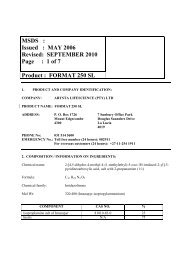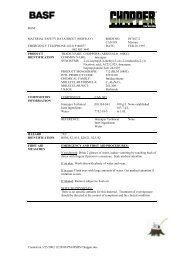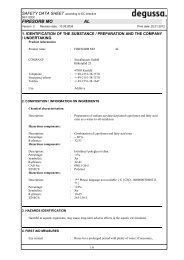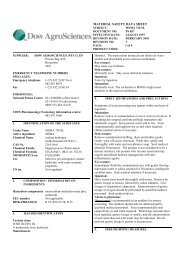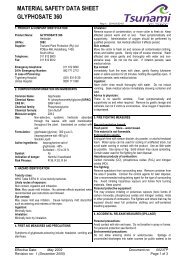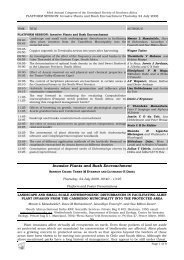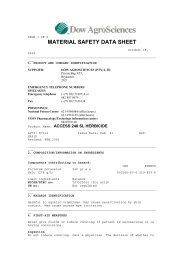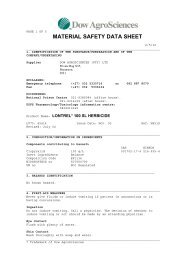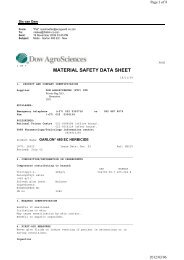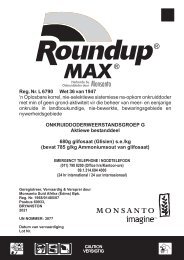MSDS - Bush Encroachment
MSDS - Bush Encroachment
MSDS - Bush Encroachment
Create successful ePaper yourself
Turn your PDF publications into a flip-book with our unique Google optimized e-Paper software.
MONSANTO Europe S.A. Page: 4 / 8Roundup® WeatherMax Version: 1.0 Effective date: 12.07.2007No special requirement when used as recommended.Eye protectionIf there is significant potential for contact:Wear chemical goggles.Skin protectionWear chemical resistant gloves.Wear chemical resistant clothing/footwear.Respiratory protectionNo special requirement when used as recommended.When recommended, consult manufacturer of personal protective equipment for the appropriate type ofequipment for a given application.9. PHYSICAL AND CHEMICAL PROPERTIESThese physical data are typical values based on material tested but may vary from sample to sample. Typicalvalues should not be construed as a guaranteed analysis of any specific lot or as specifications for the product.Colour/colour range: Yellow - OrangeOdour: Slight, AminesForm: LiquidPhysical form changes (melting, boiling, etc.):Melting point: Not available.Boiling point: Not applicable.Flash point: Does not flash.Explosive properties: No explosive propertiesAuto ignition temperature: 520 °CSpecific gravity: 1.353 @ 20 °C / 4 °CVapour pressure: No significant volatility; aqueous solution.Vapour density: Not applicable.Evaporation rate: No data.Dynamic viscosity: 72.1 mPa·s @ 20 °CKinematic viscosity: 53.29 mm2/s @ 20 °CDensity: 1.353 g/cm3 @ 20 °CSolubility: Water: Completely miscible.pH: 4.9 @ 10 g/lPartition coefficient: log Pow: < -3.2 @ 25 °C (glyphosate)10. STABILITY AND REACTIVITYStabilityStable under normal conditions of handling and storage.Oxidizing propertiesNo data.Materials to avoid/ReactivityReacts with galvanised steel or unlined mild steel to produce hydrogen, a highly flammable gas that couldexplode.Hazardous decompositionThermal decomposition: Hazardous products of combustion: see section 5.Self-accelerating decomposition temperature (SADT)No data.
MONSANTO Europe S.A. Page: 5 / 8Roundup® WeatherMax Version: 1.0 Effective date: 12.07.200711. TOXICOLOGICAL INFORMATIONThis section is intended for use by toxicologists and other health professionals.Data obtained on similar products and on components are summarized below.Similar formulationAcute oral toxicityRat, LD50: > 5,000 mg/kg body weightAcute dermal toxicityRat, LD50: > 5,000 mg/kg body weightSkin irritationRabbit, 3 animals, OECD 404 test:Redness, individual EU scores: 2.00; 1.67; 2.00Swelling, individual EU scores: 0.00; 0.33; 0.33Days to heal: 14Eye irritationRabbit, 3 animals, OECD 405 test:Conjunctival redness, individual EU scores: 1.00; 1.33; 1.33Conjunctival swelling, individual EU scores: 1.00; 1.33; 1.00Corneal opacity, individual EU scores: 0.00; 1.00; 0.00Iris lesions, individual EU scores: 0.00; 0.33; 0.00Days to heal: 3Slightly irritating to eyes but not sufficient for classification.Acute inhalation toxicityRat, LC50, 4 hours, aerosol: > 1.20 mg/LNo mortality. For purposes of the inhalation test, product was artificially aerosolized. Since this materialwill not become aerosolized to a hazardous concentration during transport, it is classified as non-hazardousunder the transportation regulations in accordance with 2.6.2.2.4.7(b) and (c) of the UN Recommendationson the Transport of Dangerous Goods.Skin sensitizationGuinea pig, 3-induction Buehler test:Positive incidence: 0 %N-(phosphonomethyl)glycine; {glyphosate}MutagenicityIn vitro and in vivo mutagenicity test(s):Not mutagenic.Repeated dose toxicityRabbit, dermal, 21 days:NOAEL toxicity: > 5,000 mg/kg body weight/dayTarget organs/systems: noneOther effects: noneRat, oral, 3 months:NOAEL toxicity: > 20,000 mg/kg dietTarget organs/systems: noneOther effects: noneChronic effects/carcinogenicityMouse, oral, 24 months:NOEL tumour: > 30,000 mg/kg dietNOAEL toxicity: ~ 5,000 mg/kg dietTumours: noneTarget organs/systems: liverOther effects: decrease of body weight gain, histopathologic effectsRat, oral, 24 months:NOEL tumour: > 20,000 mg/kg dietNOAEL toxicity: ~ 8,000 mg/kg diet
MONSANTO Europe S.A. Page: 6 / 8Roundup® WeatherMax Version: 1.0 Effective date: 12.07.2007Tumours: noneTarget organs/systems: eyesOther effects: decrease of body weight gain, histopathologic effectsToxicity to reproduction/fertilityRat, oral, 2 generations:NOAEL toxicity: 10,000 mg/kg dietNOAEL reproduction: > 30,000 mg/kg dietTarget organs/systems in parents: noneOther effects in parents: decrease of body weight gainTarget organs/systems in pups: noneOther effects in pups: decrease of body weight gainEffects on offspring only observed with maternal toxicity.Developmental toxicity/teratogenicityRat, oral, 6 - 19 days of gestation:NOAEL toxicity: 1,000 mg/kg body weightNOAEL development: 1,000 mg/kg body weightOther effects in mother animal: decrease of body weight gain, decrease of survivalDevelopmental effects: weight loss, post-implantation loss, delayed ossificationEffects on offspring only observed with maternal toxicity.Rabbit, oral, 6 - 27 days of gestation:NOAEL toxicity: 175 mg/kg body weightNOAEL development: 175 mg/kg body weightTarget organs/systems in mother animal: noneOther effects in mother animal: decrease of survivalDevelopmental effects: none12. ECOLOGICAL INFORMATIONThis section is intended for use by ecotoxicologists and other environmental specialists.Data obtained on product, similar products and on components are summarized below.Aquatic toxicity, fishRainbow trout (Oncorhynchus mykiss):Acute toxicity, 96 hours, semi-static, LC50: 3.13 mg/LAquatic toxicity, algae/aquatic plantsGreen algae (Selenastrum capricornutum):Acute toxicity, 72 hours, static, ErC50 (growth rate): 0.294 mg/LArthropod toxicityHoney bee (Apis mellifera):Contact, 48 hours, LD50: > 250 µg/beeHoney bee (Apis mellifera):Oral, 48 hours, LD50: > 238.8 µg/beeSoil organism toxicity, invertebratesEarthworm (Eisenia foetida):Acute toxicity, 14 days, LC50: > 10,000 mg/kg dry soilSoil organism toxicity, microorganismsNitrogen and carbon transformation test:40 L/ha, 28 days: Less than 25% effect on nitrogen or carbon transformation processes in soil.Similar formulationAquatic toxicity, invertebratesWater flea (Daphnia magna):Acute toxicity, 48 hours, static, EC50: 8.0 mg/LN-(phosphonomethyl)glycine; {glyphosate}Avian toxicityBobwhite quail (Colinus virginianus):Dietary toxicity, 5 days, LC50: > 4,640 mg/kg diet
MONSANTO Europe S.A. Page: 7 / 8Roundup® WeatherMax Version: 1.0 Effective date: 12.07.2007Mallard duck (Anas platyrhynchos):Dietary toxicity, 5 days, LC50: > 4,640 mg/kg dietBobwhite quail (Colinus virginianus):Acute oral toxicity, single dose, LD50: > 3,851 mg/kg body weightBioaccumulationBluegill sunfish (Lepomis macrochirus):Whole fish: BCF: < 1No significant bioaccumulation is expected.DissipationSoil, field:Half life: 2 - 174 daysKoc: 884 - 60,000 L/kgAdsorbs strongly to soil.Water, aerobic:Half life: < 7 days13. DISPOSAL CONSIDERATIONSProductRecycle if appropriate facilities/equipment available.Burn in special, controlled high temperature incinerator.Dispose of as hazardous industrial waste.Keep out of drains, sewers, ditches and water ways.Follow all local/regional/national/international regulations.ContainerSee the individual container label for disposal information.Emptied containers retain vapour and product residue.Observe all labelled safeguards until container is cleaned, reconditioned or destroyed.Empty packaging completely.Triple or pressure rinse empty containers.Pour rinse water into spray tank.Ensure packaging cannot be reused.Follow all local/regional/national/international regulations.Use handling recommendations in Section 7 and personal protection recommendations in Section 8.14. TRANSPORT INFORMATIONThe data provided in this section is for information only. Please apply the appropriate regulations to properlyclassify your shipment for transportation.ADR/RIDENVIRONMENTALLY HAZARDOUS SUBSTANCE, LIQUID, N.O.S. , (cocosfattyamine oxethylate)UN No.: UN3082Class: 9Kemler: 90Packing Group: IIIIMOENVIRONMENTALLY HAZARDOUS SUBSTANCE, LIQUID, N.O.S. , (cocosfattyamine oxethylate)UN No.: UN3082Class: 9Packing Group: IIIIATA/ICAOENVIRONMENTALLY HAZARDOUS SUBSTANCE, LIQUID, N.O.S. , (cocosfattyamine oxethylate)UN No.: UN3082Class: 9Packing Group: III
MONSANTO Europe S.A. Page: 8 / 8Roundup® WeatherMax Version: 1.0 Effective date: 12.07.200715. REGULATORY INFORMATIONEU label (manufacturer self-classification) - Classification following the EU Dangerous Preparations'Directive 1999/45/EC.Xi - Irritant, N - Dangerous for the environmentR38Irritating to skin.R50/53 Very toxic to aquatic organisms, may cause long-term adverse effects in the aquaticenvironment.S35This material and its container must be disposed of in a safe way.S37Wear suitable gloves.S57Use appropriate containment to avoid environmental contamination.16. OTHER INFORMATIONThe information given here is not necessarily exhaustive but is representative of relevant, reliable data.Follow all local/regional/national/international regulations.Please consult supplier if further information is needed.In this document the British spelling was applied.This Safety Data Sheet has been prepared following the EU Directive 91/155/EEC as last amended by EUDirective 2001/58/EC.|| Significant changes versus previous edition.EU Symbols & R phrases of componentsComponentsEU Symbols & R phrases of componentsPotassium salt of glyphosateN - Dangerous for the environmentR51/53 Toxic to aquatic organisms, may cause long-term adverse effects in the aquatic environment.Surfactant and minor formulatingingredientsWaterEndnotes:{a} EU label (manufacturer self-classification){b} EU label (Annex I){c} National classificationFull denomination of most frequently used acronyms. BCF (Bioconcentration Factor), BOD (Biochemical Oxygen Demand), COD(Chemical Oxygen Demand), EC50 (50% effect concentration), ED50 (50% effect dose), I.M. (intramuscular), I.P. (intraperitoneal), I.V.(intravenous), Koc (Soil adsorption coefficient), LC50 (50% lethality concentration), LD50 (50% lethality dose), LDLo (Lower limit of lethaldosage), LEL (Lower Explosion Limit), LOAEC (Lowest Observed Adverse Effect Concentration), LOAEL (Lowest Observed AdverseEffect Level), LOEC (Lowest Observed Effect Concentration), LOEL (Lowest Observed Effect Level), MEL (Maximum Exposure limit),MTD (Maximum Tolerated Dose), NOAEC (No Observed Adverse Effect Concentration), NOAEL (No Observed Adverse Effect Level),NOEC (No Observed Effect Concentration), NOEL (No Observed Effect Level), OEL (Occupational Exposure Limit), PEL (PermissibleExposure Limit), PII (Primary Irritation Index), Pow (Partition coefficient n-octanol/water), S.C. (subcutaneous), STEL (Short-TermExposure Limit), TLV-C (Threshold Limit Value-Ceiling), TLV-TWA (Threshold Limit Value - Time Weighted Average), UEL (UpperExplosion Limit)Although the information and recommendations set forth herein (hereinafter "Information") arepresented in good faith and believed to be correct as of the date hereof, MONSANTO Company or anyof its subsidiaries makes no representations as to the completeness or accuracy thereof. Information issupplied upon the condition that the persons receiving same will make their own determination as toits suitability for the purposes prior to use. In no event will MONSANTO Company or any of itssubsidiaries be responsible for damages of any nature whatsoever resulting from the use of or relianceupon information. NO REPRESENTATIONS OR WARRANTIES, EITHER EXPRESS ORIMPLIED, OF MERCHANTABILITY, FITNESS FOR A PARTICULAR PURPOSE OR OF ANYOTHER NATURE ARE MADE HEREUNDER WITH RESPECT TO INFORMATION OR TO THEPRODUCT TO WHICH INFORMATION REFERS.000000021580 End of document



